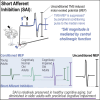TMS-derived short afferent inhibition discriminates cognitive status in older adults without dementia
- PMID: 39132326
- PMCID: PMC11315225
- DOI: 10.1016/j.nbas.2024.100123
TMS-derived short afferent inhibition discriminates cognitive status in older adults without dementia
Abstract
Aging is a complex and diverse biological process characterized by progressive molecular, cellular, and tissue damage, resulting in a loss of physiological integrity and heightened vulnerability to pathology. This biological diversity corresponds with highly variable cognitive trajectories, which are further confounded by genetic and environmental factors that influence the resilience of the aging brain. Given this complexity, there is a need for neurophysiological indicators that not only discern physiologic and pathologic aging but also closely align with cognitive trajectories. Transcranial Magnetic Stimulation (TMS) may have utility in this regard as a non-invasive brain stimulation tool that can characterize features of cortical excitability. Particularly, as a proxy for central cholinergic function, short-afferent inhibition (SAI) dysfunction is robustly associated with cognitive deficits in the latter stages of Alzheimer's Disease and Related Dementia (ADRD). In this study, we evaluated SAI in healthy young adults and older adults who, though absent clinical diagnoses, were algorithmically classified as cognitively normal (CN) or cognitively impaired (CI) according to the Jak/Bondi actuarial criteria. We report that SAI is preserved in the Old-CN cohort relative to the young adults, and SAI is significantly diminished in the Old-CI cohort relative to both young and CN older adults. Additionally, diminished SAI was significantly associated with impaired sustained attention and working memory. As a proxy measure for central cholinergic deficits, we discuss the potential value of SAI for discerning physiological and pathological aging.
Keywords: Cognitive Aging; Dementia; Transcranial Magnetic Stimulation.
© 2024 The Authors. Published by Elsevier Inc.
Conflict of interest statement
The authors declare that they have no known competing financial interests or personal relationships that could have appeared to influence the work reported in this paper.
Figures


Similar articles
-
The contribution of transcranial magnetic stimulation in the diagnosis and in the management of dementia.Clin Neurophysiol. 2014 Aug;125(8):1509-32. doi: 10.1016/j.clinph.2014.04.010. Epub 2014 Apr 30. Clin Neurophysiol. 2014. PMID: 24840904 Review.
-
Cholinergic circuitry functioning in patients with vascular cognitive impairment--no dementia.Brain Stimul. 2016 Mar-Apr;9(2):225-33. doi: 10.1016/j.brs.2015.09.013. Epub 2015 Oct 9. Brain Stimul. 2016. PMID: 26515786 Clinical Trial.
-
Preserved central cholinergic functioning to transcranial magnetic stimulation in de novo patients with celiac disease.PLoS One. 2021 Dec 16;16(12):e0261373. doi: 10.1371/journal.pone.0261373. eCollection 2021. PLoS One. 2021. PMID: 34914787 Free PMC article.
-
Age-related differences in long-term potentiation-like plasticity and short-latency afferent inhibition and their association with cognitive function.Gen Psychiatr. 2024 Feb 21;37(1):e101181. doi: 10.1136/gpsych-2023-101181. eCollection 2024. Gen Psychiatr. 2024. PMID: 38390239 Free PMC article.
-
Transcranial Magnetic Stimulation as a Diagnostic and Therapeutic Tool in Various Types of Dementia.J Clin Med. 2021 Jun 28;10(13):2875. doi: 10.3390/jcm10132875. J Clin Med. 2021. PMID: 34203558 Free PMC article. Review.
References
-
- Tatullo M. Entropy meets physiology: should we translate aging as disorder? Stem Cells. 2023;42:91–97. - PubMed
LinkOut - more resources
Full Text Sources
Research Materials

